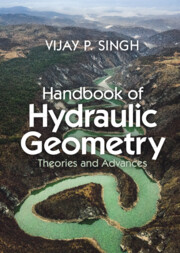Book contents
- Handbook of Hydraulic Geometry
- Handbook of Hydraulic Geometry
- Copyright page
- Dedication
- Contents
- Preface
- Acknowledgments
- 1 Introduction
- 2 Governing Equations
- 3 Regime Theory
- 4 Leopold–Maddock (LM) Theory
- 5 Theory of Minimum Variance
- 6 Dimensional Principles
- 7 Hydrodynamic Theory
- 8 Scaling Theory
- 9 Tractive Force Theory
- 10 Thermodynamic Theory
- 11 Similarity Principle
- 12 Channel Mobility Theory
- 13 Maximum Sediment Discharge and Froude Number Hypothesis
- 14 Principle of Minimum Froude Number
- 15 Hypothesis of Maximum Friction Factor
- 16 Maximum Flow Efficiency Hypothesis
- 17 Principle of Least Action
- 18 Theory of Minimum Energy Dissipation Rate
- 19 Entropy Theory
- 20 Minimum Energy Dissipation and Maximum Entropy Theory
- 21 Theory of Stream Power
- 22 Regional Hydraulic Geometry
- Index
- References
22 - Regional Hydraulic Geometry
Published online by Cambridge University Press: 24 November 2022
- Handbook of Hydraulic Geometry
- Handbook of Hydraulic Geometry
- Copyright page
- Dedication
- Contents
- Preface
- Acknowledgments
- 1 Introduction
- 2 Governing Equations
- 3 Regime Theory
- 4 Leopold–Maddock (LM) Theory
- 5 Theory of Minimum Variance
- 6 Dimensional Principles
- 7 Hydrodynamic Theory
- 8 Scaling Theory
- 9 Tractive Force Theory
- 10 Thermodynamic Theory
- 11 Similarity Principle
- 12 Channel Mobility Theory
- 13 Maximum Sediment Discharge and Froude Number Hypothesis
- 14 Principle of Minimum Froude Number
- 15 Hypothesis of Maximum Friction Factor
- 16 Maximum Flow Efficiency Hypothesis
- 17 Principle of Least Action
- 18 Theory of Minimum Energy Dissipation Rate
- 19 Entropy Theory
- 20 Minimum Energy Dissipation and Maximum Entropy Theory
- 21 Theory of Stream Power
- 22 Regional Hydraulic Geometry
- Index
- References
Summary
Relationships relating channel width, depth, and cross-section as well as discharge to drainage basin area are regional relationships, because they are developed at the basin scale. These relationships constitute regional hydraulic geometry, which is utilized in stream assessments, evaluating channel characteristics, identifying field indicators of bankfull discharge, and delineation of regional boundaries, hydrologic regions, and ecoregions. This chapter presents these regional relationships.
Keywords
- Type
- Chapter
- Information
- Handbook of Hydraulic GeometryTheories and Advances, pp. 529 - 554Publisher: Cambridge University PressPrint publication year: 2022
References
- 1
- Cited by

